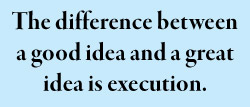The Difference Between a Good Idea and a Great Idea
Ed Young
Fabricator’s Business Coach
Two companies decided to purchase and install their first CNC router. Company A installed the CNC, the shop is running well, and they are making more money than ever. Company B struggled to install the CNC and is constantly having problems as a result. Jobs are running late. Customers are upset. Profits are taking a hit.

Why did Company A have success integrating a CNC into their operation where Company B didn’t?
- Both companies installed the same brand and model of CNC.
- Both companies are about the same size, have been in business for about the same length of time, are in similar markets, and have a similar customer base.
- Both companies visited other fabricators to learn about how the CNC worked in those plants.
- Both put together project plans and revised their plant layouts.
- Both companies had their people trained.
Yet one was successful with their CNC install and one wasn’t. What was the difference?
 When Company A visited fabricators to learn about CNCs, they planned the visits.
When Company A visited fabricators to learn about CNCs, they planned the visits.
- Several people made the trip.
- They planned the questions to be asked.
- They talked to operators and managers.
- After the trip, they compared notes, documented lessons learned, and revised their questions for the next visit.
When Company B visited:
- Only the owner went because he didn’t want to spend the money to take the other folks – and, besides, someone needed to stay and run the shop.
- Company B’s owner talked mainly to the other owner and a couple of managers.
- The same approach was used for the other visits.
When the new CNC arrived, Company A was prepared, and the installation went well. The machine was up and running in a day or two. The operators were trained, and the first test runs went well. Although they had a few missteps, the first project went well, and the CNC was quickly helping improve operations.
When the new CNC arrived at Company B, things went downhill in a hurry:
- They didn’t have the right equipment to unload the truck
- The power supply wasn’t adequate so the operator couldn’t be trained as planned
- When the machine was finally ready to run, the operator quit a few days before the training was scheduled. The supervisor received the training but, because he was frequently interrupted during the sessions, he missed a few things. His hit-and-miss training of the new operator wasn’t too effective.
- You can pretty much guess how things went from there…
 The difference in these two examples is Company A simply executed better than Company B. Both had access to the same information, both had similar resources, and both had the same objective. How they executed their planning and how they executed the implementation made the difference.
The difference in these two examples is Company A simply executed better than Company B. Both had access to the same information, both had similar resources, and both had the same objective. How they executed their planning and how they executed the implementation made the difference.
You can have a lot of good ideas but, if you can’t make them happen, they are worthless. Great ideas are the good ideas that were executed well. Great ideas are the ones that generate results.
So, what is the key to good execution?
1. FOCUS
One person in charge. When Company A started planning this project, they made this the primary focus for the plant manager. This meant:
- Other initiatives like optimizing the Robo Saw or deciding on a new miter machine were paused until the new CNC was up and running.
- He was the one go-to person for all decisions. He was the one person in charge of the project. There was no uncertainty about who made decisions.
- Others pitched in as needed to help with running the shop and/or handle various tasks in the project.
A clearly defined objective
- Purchasing the CNC was justified by a financial analysis. The project was not considered complete until those results had been achieved.
- The steps needed to achieve that financial result drove the structure and timing of the project plan.
- The financial results and the project plan were shared with the entire company, so everyone understood what was happening and their role in the project.
2. CONTINUOUSLY TRACKING AND COMMUNICATING PROJECT STATUS
- The core team met weekly and reviewed the status of project milestones.
- Updates were posted to the visual project board so everyone in the company could see the status.
- When any aspect of the plan threatened the overall schedule, one person was assigned responsibility for getting it back on track and updating the team.
- Regular communication with the machine vendor and subcontractors was tracked and reported.
3. CELEBRATE SUCCESS
As milestones in the project plan were achieved, participants were rewarded:
- An individual who took initiative to keep a project item from running late was given a gift certificate for a nice meal with his/her partner.
- A team had to work late to get a customer’s job completed on time because production was interrupted by the electrical contractor. They were recognized at the monthly company meeting and given gift cards.
- When the entire project was successfully completed, everyone in the company was treated to a catered BBQ on Friday.
Lots of folks have good ideas. Those ideas only become great when they are executed effectively.
While there are several good books out there on execution, one of the best is The 4 Disciplines of Execution. It is an easy read with lots of examples and includes an extensive how-to section.
As a fab shop owner, you deserve to have a business that makes you money and also allows you the time to enjoy it. To find out more about how to make more money and get your life back, email the author at Ed@FabricatorsCoach.com.